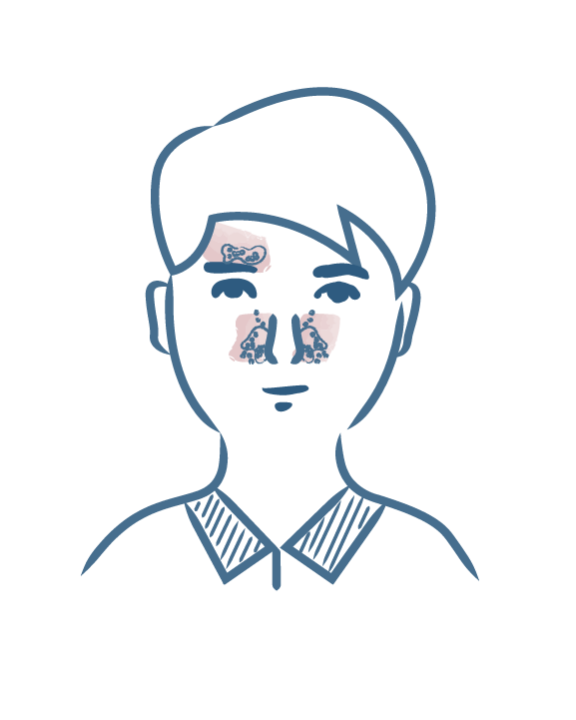What is the best treatment for seborrheic dermatitis?

What is the best shampoo to use for seborrheic dermatitis?
In adults and children over 12 years of age, seborrheic dermatitis of the scalp is managed using a treatment shampoo. Dermo-cosmetic shampoos will always be combined with medicinal treatments to reduce the risk of possible relapses. However, in some cases, dermo-cosmetic products alone can be effective against seborrheic dermatitis. Your physician will make a decision based on the severity of your condition and the associated symptoms.
Medicinal shampoos and seborrheic dermatitis
Medicinal treatment shampoos generally act against Malassezia yeast by limiting its proliferation and provide anti-inflammatory action to alleviate symptoms. These shampoos therefore play an important role in the treatment of seborrheic dermatitis.
- Shampoos based on ketoconazole (1,2,3), are the first-line treatment in the event of the scalp being affected by seborrheic dermatitis. They are applied twice a week for two to four weeks. Their mechanism of action is based on their anti-fungal and anti-inflammatory action. Some adverse effects, fortunately very rare, such as irritation, pruritus (or itching), contact eczema, or very rarely the modification of the color of gray or tinted hair, can sometimes be observed with this treatment.
- Miconazole nitrate shampoos (4) act in the same way as ketoconazole shampoos and their dosage is identical.
- Shampoos based on ciclopirox olamine (4,5) are applied two or three times a week for four weeks. They provide anti-fungal and anti-inflammatory action. They are just as effective as ketoconazole.
- Shampoos based on selenium disulfide (6) act by reducing the proliferation of cells and therefore dandruff but also against the proliferation of yeast of the Malassezia genus. In comparison with ketoconazole, selenium disulfide appears to be slightly less effective and less well tolerated, with the main side effect being irritation and dryness. It is applied twice a week for two weeks and then once a week.
Dermo-cosmetic treatment shampoos and seborrheic dermatitis
There are also numerous dermo-cosmetic treatment shampoos available in pharmacies. To find your way through all the ranges, it's simple, their name is generally accompanied by the initials S.D., for seborrheic dermatitis.
These shampoos combine keratolytic action, to eliminate scales, with anti-fungal action, to limit the proliferation of yeast of the Malassezia genus. They also have an anti-inflammatory effect to soothe the irritated scalp, reduce redness and soothe itching.
The frequency of use of these anti-seborrheic dermatitis shampoos is approximately the same as that of so-called "medicinal" shampoos. They are used two or three times a week, then as soon as the condition improves, it is recommended to continue applying them but at greater intervals in order to maintain the effects over time.
From a more practical point of view, it is advisable to apply them by gently massaging the scalp and to respect the application time indicated.
A few simple tips to follow on a daily basis
Seborrheic dermatitis causes irritation of the scalp. If you shampoo your hair more frequently than the recommended dosage of your treatment shampoo, it is advisable to alternate with more gentle and soothing shampoos for the extra shampoos. Please feel free to ask your pharmacist for advice.
Avoid using styling products such as hairsprays or gels in order to limit any risk of scalp irritation.
(1) Faergemann J, Borgers M, et al. A new ketoconazole topical gel formulation in seborrhoeic dermatitis: An updated review of the mechanism. Expert Opin Pharmacother 2007;8:1365-71. (2) Elewski BE, Abramovits W, et al. A novel foam formulation of ketoconazole 2% for the treatment of seborrheic dermatitis on multiple body regions. J Drugs Dermatol 2007;6:1001-8. (3) Elewski B, Ling MR, et al. Efficacy and safety of a new once-daily topical ketoconazole 2% gel in the treatment of seborrheic dermatitis: A phase III trial. J Drugs Dermatol 2006;5:646-50. (4) Subissi A, Monti D, et al. Ciclopirox: Recent non- clinical and clinical data relevant to its use as a topical antimycotic agent. Drugs 2010;70:2133-52. (5) Ratnavel RC, Squire RA, et al. Clinical efficacies of shampoos containing ciclopirox olamine (1.5%) and ketoconazole (2%) in the treatment of seborrhoeic dermatitis. J Dermatolog Treat 2007;18:88-96. (6) Danby FW, Maddin WS, et al. A randomized, double-blind, placebo-controlled trial of ketoconazole 2% shampoo versus selenium sulfide 2.5% shampoo in the treatment of moderate to severe dandruff. J Am Acad Dermatol 1993;29:1008-12.
More information
- Discover What is the best cream to fight seborrheic dermatitis?
What is the best treatment for seborrheic dermatitis?
What is the best cream to fight seborrheic dermatitis?
Our care routines
Irritated skin with redness and scales

